Report on Cleveland (United States) — May 2011
Bulletin of the Global Volcanism Network, vol. 36, no. 5 (May 2011)
Managing Editor: Richard Wunderman.
Edited by Jen Fela.
Cleveland (United States) Thermal anomalies and possible plumes through mid-September 2010
Please cite this report as:
Global Volcanism Program, 2011. Report on Cleveland (United States) (Fela, J., and Wunderman, R., eds.). Bulletin of the Global Volcanism Network, 36:5. Smithsonian Institution. https://doi.org/10.5479/si.GVP.BGVN201105-311240
Cleveland
United States
52.825°N, 169.944°W; summit elev. 1730 m
All times are local (unless otherwise noted)
Occasional small ash eruptions occurred at Cleveland during 2009 through early June 2010 (BGVN 35:06). Mild restless behavior continued at least into mid-September 2010 but it was uncertain whether ash had been emitted.
Table 3 compiles key observations and alerts for Cleveland volcano during mid-June through 31 March 2011. The Alaska Volcano Observatory (AVO) reported that thermal anomalies were sometimes visible and sometimes absent on satellite imagery. One or two ash plumes may have also been emitted. Accordingly, these observations caused authorities to raise and lower the Volcano Alert Level and Aviation Color Code (table 3). Volcano seismicity was absent because Cleveland lacks a real-time seismic network. The thermal anomalies and possible plumes could both could stem from steam emissions (see AVO statement at bottom of this report).
Table 3. Reports of activity at Cleveland based on satellite imagery during 10 June 2010 through 31 March 2011. Also shown are Volcano Alert Level and Aviation Color Code fluctuations based on that activity. Courtesy AVO.
| Date | Observation based on satellite imagery | Volcano Alert Level | Aviation Color Code |
| 10 Jun 2010 | -- | Advisory | Yellow |
| 11 Jun 2010 | -- | Unassigned | Unassigned |
| 16 Aug-1 Sep 2010 | Thermal anomalies visible on most days | -- | -- |
| 26 Aug 2010 | -- | Advisory | Yellow |
| 07-08 Sep 2010 | Clear-weather views showed no thermal anomalies or recent deposits on the flanks | -- | -- |
| 08 Sep 2010 | -- | Unassigned | Unassigned |
| 11 Sep 2010 | Thermal anomaly visible | -- | -- |
| 12 Sep 2010 | Possible ash plume rose to ~7.6-km altitude and drifted E | -- | -- |
| 12 Sep 2010 | -- | Advisory | Yellow |
| 13-15 Sep 2010 | Thermal anomalies visible | -- | -- |
| 16-24 Sep 2010 | Cloud cover prevented views | -- | -- |
| 25-26 Sep 2010 | Weak thermal anomaly visible | -- | -- |
| 27-28 Sep 2010 | Cloud cover prevented views | -- | -- |
| 31 Mar 2011 | -- | Unassigned | Unassigned |
On 12 September 2010, a possible ash plume was visible in satellite imagery; it rose to an estimated altitude of 7.6 km and drifted E. A 14 September image showed a dense white plume issuing from Cleveland (figure 9).
On 31 March 2011, AVO lowered the Volcano Alert Level and the Aviation Color Code to Unassigned, noting that no eruptive activity had been confirmed during the previous few months. No significant thermal anomalies or ash deposits on snow were observed in satellite imagery.
In its 31 March 2011 report, AVO stated that "Cleveland experiences frequent episodes of low-level unrest; the summit crater at Cleveland often emits visible plumes of water vapor and possibly small quantities of volcanic gas. Heat associated with this process can produce occasional weak thermal anomalies detected by satellite; however, these do not always indicate eruptive activity has occurred or is imminent."
AVO also stated, in an earlier report, that low-level ash emissions at Cleveland occur frequently and also do not necessarily mean that a larger eruption is imminent.
Geological Summary. The beautifully symmetrical Mount Cleveland stratovolcano is situated at the western end of the uninhabited Chuginadak Island. It lies SE across Carlisle Pass strait from Carlisle volcano and NE across Chuginadak Pass strait from Herbert volcano. Joined to the rest of Chuginadak Island by a low isthmus, Cleveland is the highest of the Islands of the Four Mountains group and is one of the most active of the Aleutian Islands. The native name, Chuginadak, refers to the Aleut goddess of fire, who was thought to reside on the volcano. Numerous large lava flows descend the steep-sided flanks. It is possible that some 18th-to-19th century eruptions attributed to Carlisle should be ascribed to Cleveland (Miller et al., 1998). In 1944 it produced the only known fatality from an Aleutian eruption. Recent eruptions have been characterized by short-lived explosive ash emissions, at times accompanied by lava fountaining and lava flows down the flanks.
Information Contacts: Alaska Volcano Observatory (AVO), a cooperative program of the U.S. Geological Survey, 4200 University Drive, Anchorage, AK 99508-4667, USA; Geophysical Institute, University of Alaska, PO Box 757320, Fairbanks, AK 99775-7320, USA; and Alaska Division of Geological & Geophysical Surveys, 794 University Ave., Suite 200, Fairbanks, AK 99709, USA (URL: http://www.avo.alaska.edu/).


